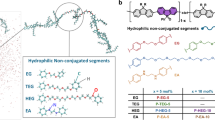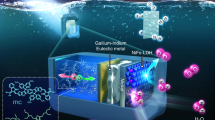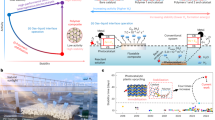Abstract
The photoinduced polymerization of electron-rich heteroaromatic pentacycles (ERHPs), such as thiophene derivatives and pyrrole derivatives, is challenging owing to the inherent stability of their aromatic structure. The resultant polymers are organic semiconductor materials that are widely used in both organic electronic and bioelectronic devices. Here we report an efficient hydrogen-atom transfer (HAT) photocatalyst, which is the dimerization product (1,2-bis(4-(2-hydroxyethoxy)phenyl)ethane-1,2-dione) of an acyl radical generated by the photolysis of Irgacure 2959, and its use for the dehydrogenation of coupled ERHPs formed in an acidic environment. The dehydrogenation occurs via a double HAT process, enabling the photopolymerization of ERHPs. This reaction also allows us to fabricate three-dimensional (3D) conductive pathways in hydrogels. The hydrogel can be printed to form free-standing 3D conductive structures of poly(3,4-ethylenedioxythiophene):polystyrene sulfonate with a precision of 220 nm, markedly surpassing structures built using previous methods (>10 µm). The approach introduces opportunities for precision engineering of 3D electrodes with the possibility of expanding applications in organic electronics and bioelectronics.

This is a preview of subscription content, access via your institution
Access options
Subscribe to this journal
Receive 12 digital issues and online access to articles
$119.00 per year
only $9.92 per issue
Buy this article
- Purchase on SpringerLink
- Instant access to full article PDF
Prices may be subject to local taxes which are calculated during checkout







Similar content being viewed by others
Data availability
All data to support the findings of this study are available within the paper and its Supplementary Information. Source data are provided with this paper.
References
Anderson, C. L. et al. Exceptional electron-rich heteroaromatic pentacycle for ultralow band gap conjugated polymers and photothermal therapy. J. Am. Chem. Soc. 145, 5474–5485 (2023).
Heinze, J., Frontana-Uribe, B. A. & Ludwigs, S. Electrochemistry of conducting polymers—persistent models and new concepts. Chem. Rev. 110, 4724–4771 (2010).
Chakraborty, B. & Luscombe, C. K. Cross-dehydrogenative coupling polymerization via C–H activation for the synthesis of conjugated polymers. Angew. Chem. Int. Ed. 62, e202301247 (2023).
Xie, X. et al. Liquid-in-liquid printing of 3D and mechanically tunable conductive hydrogels. Nat. Commun. 14, 4289 (2023).
Yuk, H. et al. 3D printing of conducting polymers. Nat. Commun. 11, 1604 (2020).
Fazekas, T. J. et al. Diversification of aliphatic C–H bonds in small molecules and polyolefins through radical chain transfer. Science 375, 545–550 (2022).
Hendrich, C. M., Sekine, K., Koshikawa, T., Tanaka, K. & Hashmi, A. S. K. Homogeneous and heterogeneous gold catalysis for materials science. Chem. Rev. 121, 9113–9163 (2021).
Zhang, W. et al. Enantioselective cyanation of benzylic C–H bonds via copper-catalyzed radical relay. Science 353, 1014–1018 (2016).
Cao, H., Tang, X., Tang, H., Yuan, Y. & Wu, J. Photoinduced intermolecular hydrogen atom transfer reactions in organic synthesis. Chem. Catal. 1, 523–598 (2021).
Ahn, D., Stevens, L. M., Zhou, K. & Page, Z. A. Additives for ambient 3D printing with visible light. Adv. Mater. 33, 2104906 (2021).
Tang, H. et al. A solution-processed n-type conducting polymer with ultrahigh conductivity. Nature 611, 271–277 (2022).
Heywang, G. & Jonas, F. Poly(alkylenedioxythiophene)s—new, very stable conducting polymers. Adv. Mater. 4, 116–118 (1992).
Russ, B., Glaudell, A., Urban, J. J., Chabinyc, M. L. & Segalman, R. A. Organic thermoelectric materials for energy harvesting and temperature control. Nat. Rev. Mater. 1, 16050 (2016).
Someya, T., Bao, Z. & Malliaras, G. G. The rise of plastic bioelectronics. Nature 540, 379–385 (2016).
Vazquez-Guardado, A., Yang, Y., Bandodkar, A. J. & Rogers, J. A. Recent advances in neurotechnologies with broad potential for neuroscience research. Nat. Neurosci. 23, 1522–1536 (2020).
Zhang, S. et al. p-Toluenesulfonic acid catalytic polymerization of EDOT without oxidants. Mater. Lett. 222, 105–108 (2018).
Wang, J., Fang, B.-S., Chou, K.-Y., Chen, C.-C. & Gu, Y. A two-stage enzymatic synthesis of conductive poly(3,4-ethylenedioxythiophene). Enzyme Microb. Technol. 54, 45–50 (2014).
Yoon, H. & Jang, J. Conducting-polymer nanomaterials for high-performance sensor applications: issues and challenges. Adv. Funct. Mater. 19, 1567–1576 (2009).
Zhang, L. et al. The role of mineral acid doping of PEDOT:PSS and its application in organic photovoltaics. Adv. Electron. Mater. 6, 1900648 (2020).
Wu, F. et al. Conductivity enhancement of PEDOT:PSS via addition of chloroplatinic acid and its mechanism. Adv. Electron. Mater. 3, 1700047 (2017).
Chen, R. et al. Sequential solution polymerization of poly(3,4-ethylenedioxythiophene) using V2O5 as oxidant for flexible touch sensors. iScience 12, 66–75 (2019).
Shi, W. et al. Micron-thick highly conductive PEDOT films synthesized via self-inhibited polymerization: roles of anions. NPG Asia Mater. 9, e405 (2017).
Crispin, X. et al. The origin of the high conductivity of poly(3,4-ethylenedioxythiophene)–poly(styrenesulfonate) (PEDOT-PSS) plastic electrodes. Chem. Mater. 18, 4354–4360 (2006).
Mai, C. K. et al. Facile doping of anionic narrow-band-gap conjugated polyelectrolytes during dialysis. Angew. Chem. Int. Ed. 52, 12874–12878 (2013).
Jalili, R., Razal, J. M., Innis, P. C. & Wallace, G. G. One-step wet-spinning process of poly(3,4-ethylenedioxythiophene):poly(styrenesulfonate) fibers and the origin of higher electrical conductivity. Adv. Funct. Mater. 21, 3363–3370 (2011).
Scaiano, J. C., Stamplecoskie, K. G. & Hallett-Tapley, G. L. Photochemical Norrish type I reaction as a tool for metal nanoparticle synthesis: importance of proton coupled electron transfer. Chem. Commun. 48, 4798–4808 (2012).
Wilkinson, F. Transfer of triplet state energy and the chemistry of excited states. J. Phys. Chem. 66, 2569–2574 (1962).
Lee, W., Jung, S., Kim, M. & Hong, S. Site-selective direct C–H pyridylation of unactivated alkanes by triplet excited anthraquinone. J. Am. Chem. Soc. 143, 3003–3012 (2021).
Zhu, Y. et al. Visible-light enabled photochemical reduction of 1,2-dicarbonyl compounds by Hünig’s base. Org. Chem. Front. 9, 1924–1931 (2022).
Romero, N. A. & Nicewicz, D. A. Organic photoredox catalysis. Chem. Rev. 116, 10075–10166 (2016).
Schreiner, P. R. Quantum mechanical tunneling is essential to understanding chemical reactivity. Trends Chem. 2, 980–989 (2020).
Schreiner, P. R. Tunneling control of chemical reactions: the third reactivity paradigm. J. Am. Chem. Soc. 139, 15276–15283 (2017).
Meisner, J. & Kastner, J. Atom tunneling in chemistry. Angew. Chem. Int. Ed. 55, 5400–5413 (2016).
Shi, G., Xu, J. & Fu, M. Raman spectroscopic and electrochemical studies on the doping level changes of polythiophene films during their electrochemical growth processes. J. Phys. Chem. B 106, 288–292 (2002).
Huang, Z., Qu, L., Shi, G., Chen, F. & Hong, X. Electrochemical polymerization of naphthalene in the electrolyte of boron trifluoride diethyl etherate containing trifluoroacetic acid and polyethylene glycol oligomer. J. Electroanal. Chem. 556, 159–165 (2003).
Lu, G. & Shi, G. Electrochemical polymerization of pyrene in the electrolyte of boron trifluoride diethyl etherate containing trifluoroacetic acid and polyethylene glycol oligomer. J. Electroanal. Chem. 586, 154–160 (2006).
Li, C., Chen, F., Shi, G., Xu, J. & Xu, Z. Electrosynthesis of free-standing poly(para-phenylene) films in mixed electrolytes of boron trifluoride diethyl etherate and trifluoroacetic acid on stainless steel electrode. J. Appl. Polym. Sci. 83, 2462–2466 (2002).
Hilal, M. & Han, J. I. Interface engineering of G-PEDOT:PSS hole transport layer via interlayer chemical functionalization for enhanced efficiency of large-area hybrid solar cells and their charge transport investigation. Sol. Energy 174, 743–756 (2018).
Khan, S. & Narula, A. K. Bio-hybrid blended transparent and conductive films PEDOT:PSS:chitosan exhibiting electro-active and antibacterial properties. Eur. Polym. J. 81, 161–172 (2016).
Zozoulenko, I. et al. Polarons, bipolarons, and absorption spectroscopy of PEDOT. ACS Appl. Polym. Mater. 1, 83–94 (2019).
Ouyang, L., Musumeci, C., Jafari, M. J., Ederth, T. & Inganas, O. Imaging the phase separation between PEDOT and polyelectrolytes during processing of highly conductive PEDOT:PSS films. ACS Appl. Mater. Interfaces 7, 19764–19773 (2015).
Li, X. et al. Deciphering the superior thermoelectric property of post-treatment-free PEDOT:PSS/IL hybrid by X-ray and neutron scattering characterization. Npj Flex. Electron. 6, 6 (2022).
Liu, Z. et al. Deciphering the quaternary structure of PEDOT:PSS aqueous dispersion with small-angle scattering. Polymer 261, 125415 (2022).
Zeng, Y. et al. Increased nitrogenase activity in solar-driven biohybrids containing non-photosynthetic bacteria and conducting polymers. Angew. Chem. Int. Ed. 62, e202303877 (2023).
Zhang, Z. et al. High-brightness all-polymer stretchable LED with charge-trapping dilution. Nature 603, 624–630 (2022).
Anand, A. et al. Why organic electronic devices comprising PEDOT:PSS electrodes should be fabricated on metal free substrates. ACS Appl. Electron. Mater. 3, 929–943 (2021).
Gao, B., An, J., Wang, Y., Wang, L. & Sillanpää, M. Comparative study of the photocatalytic, electrocatalytic and photoelectrocatalytic behaviour of poly(3,4-ethylenedioxythiophene). J. Electroanal. Chem. 858, 113742 (2020).
Strakosas, X. et al. Metabolite-induced in vivo fabrication of substrate-free organic bioelectronics. Science 379, 795–802 (2023).
Xue, Z. et al. Assembly of complex 3D structures and electronics on curved surfaces. Sci. Adv. 8, eabm6922 (2022).
Kim, J., Ghaffari, R. & Kim, D.-H. The quest for miniaturized soft bioelectronic devices. Nat. Biomed. Eng. 1, 0049 (2017).
Jiang, Y. et al. Topological supramolecular network enabled high-conductivity, stretchable organic bioelectronics. Science 375, 1411–1417 (2022).
Li, J., Cao, J., Lu, B. & Gu, G. 3D-printed PEDOT:PSS for soft robotics. Nat. Rev. Mater. 8, 604–622 (2023).
Hill, I. M. et al. Imparting high conductivity to 3D printed PEDOT:PSS. ACS Appl. Polym. Mater. 5, 3989–3998 (2023).
Tao, Y. et al. Nanostructured electrically conductive hydrogels obtained via ultrafast laser processing and self-assembly. Nanoscale 11, 9176–9184 (2019).
Kim, S. D., Kim, K. & Shin, M. Recent advances in 3D printable conductive hydrogel inks for neural engineering. Nano Convergence 10, 41 (2023).
Kern, J.-M. & Sauvage, J.-P. Photochemical deposition of electrically conducting polypyrrole. Chem. Commun. 10, 657–658 (1989).
Woods, E. F. et al. Light directs monomer coordination in catalyst-free grignard photopolymerization. J. Am. Chem. Soc. 143, 18755–18765 (2021).
Wei, H. et al. Orthogonal photochemistry-assisted printing of 3D tough and stretchable conductive hydrogels. Nat. Commun. 12, 2082 (2021).
Nguyen, D. M. et al. One pot photomediated formation of electrically conductive hydrogels. ACS Polym. Au 4, 34–44 (2024).
Woods, E. F., Berl, A. J. & Kalow, J. A. Advances in the synthesis of π-conjugated polymers by photopolymerization. ChemPhotoChem 5, 4–11 (2021).
Argun, A. A., Cirpan, A. & Reynolds, J. R. The first truly all-polymer electrochromic devices. Adv. Mater. 15, 1338–1341 (2003).
Malti, A., Gabrielsson, E. O., Crispin, X. & Berggren, M. An electrochromic bipolar membrane diode. Adv. Mater. 27, 3909–3914 (2015).
Freitag, K. et al. Screen printed reflective electrochromic displays for paper and other opaque substrates. ACS Appl. Opt. Mater. 1, 578–586 (2023).
Andersson Ersman, P. et al. Electrochromic displays screen printed on transparent nanocellulose-based substrates. Adv. Photonics Res. 4, 2200012 (2023).
Gaupp, C. L., Welsh, D. M., Rauh, R. D. & Reynolds, J. R. Composite coloration efficiency measurements of electrochromic polymers based on 3,4-alkylenedioxythiophenes. Chem. Mater. 14, 3964–3970 (2002).
Torgersen, J. et al. Hydrogels for two-photon polymerization: a toolbox for mimicking the extracellular matrix. Adv. Funct. Mater. 23, 4542–4554 (2013).
Sun, H.-B., Takada, K., Kim, M. S., Lee, K. S. & Kawata, S. Scaling laws of voxels in two-photon photopolymerization nanofabrication. Appl. Phys. Lett. 83, 1104–1106 (2003).
Frölich, A., Fischer, J., Zebrowski, T., Busch, K. & Wegener, M. Titania woodpiles with complete three-dimensional photonic bandgaps in the visible. Adv. Mater. 25, 3588–3592 (2013).
Williams, H. E., Luo, Z. & Kuebler, S. M. Effect of refractive index mismatch on multi-photon direct laser writing. Opt. Express 20, 25030–25040 (2012).
Acknowledgements
We gratefully acknowledge M. Wu and X. Zheng for their assistance with C-AFM measurements. We gratefully acknowledge Z. Wang for his assistance with the OLED preparation and characterization. We thank P. Sun for his assistance with the OSC preparation and characterization. We thank X. Xiao and J. Zhao for their help with nanosecond transient absorption measurements. All theoretical calculations were performed at the High-Performance Computing Center (HPCC) of Nanjing University. We acknowledge financial support from the National Natural Science Foundation of China (numbers 52033002, 22105035, 22122103, 22101130), the Natural Science Foundation of Jiangsu Province (numbers BK20210263, BK20211560), Fundamental Research Funds for the Central Universities (numbers 020514380304, 020514380252, 020514380272); J.H. acknowledges the support from the Xiaomi Foundation.
Author information
Authors and Affiliations
Contributions
X.Z., Z.G., J.X. and J.H. conceived the work and designed the experiments. X.Z. and X.D. performed the synthesis and characterization of materials. X.Z. and H.D. conducted the 3D printing experiments. S.F. conducted experiments on the characterization of experimental mechanisms and proposed the catalytic cycle. J.H. performed the DFT calculations. Y.H. and R.C. performed cell experiments and analysed the data. The manuscript was written with contributions from all the authors.
Corresponding authors
Ethics declarations
Competing interests
The authors declare no competing interests.
Peer review
Peer review information
Nature Synthesis thanks Guoying Gu and the other, anonymous, reviewer(s) for their contribution to the peer review of this work. Primary Handling Editor: Alison Stoddart, in collaboration with the Nature Synthesis team.
Additional information
Publisher’s note Springer Nature remains neutral with regard to jurisdictional claims in published maps and institutional affiliations.
Supplementary information
Supplementary Information
Supplementary Figs. 1–39, Discussion and Tables 1–3.
Supplementary Video 1
Colour transition of electrochromic device under cyclic voltage.
Supplementary Video 2
Rapid and repeatable colour switching of electrochromic device.
Supplementary Data
Cartesian coordinates of optimized geometries.
Source data
Source Data Fig. 2
Statistical Source Data
Source Data Fig. 6
Statistical Source Data
Rights and permissions
Springer Nature or its licensor (e.g. a society or other partner) holds exclusive rights to this article under a publishing agreement with the author(s) or other rightsholder(s); author self-archiving of the accepted manuscript version of this article is solely governed by the terms of such publishing agreement and applicable law.
About this article
Cite this article
Zhou, X., Fang, S., Hu, Y. et al. Photoinduced double hydrogen-atom transfer for polymerization and 3D printing of conductive polymer. Nat. Synth 3, 1145–1157 (2024). https://doi.org/10.1038/s44160-024-00582-w
Received:
Accepted:
Published:
Issue date:
DOI: https://doi.org/10.1038/s44160-024-00582-w
This article is cited by
-
Multimaterial cryogenic printing of three-dimensional soft hydrogel machines
Nature Communications (2025)
-
Manufacture the conducting polymer with light
Science China Chemistry (2025)



